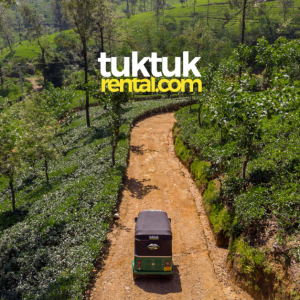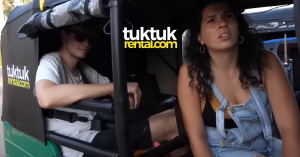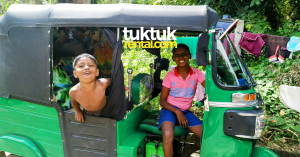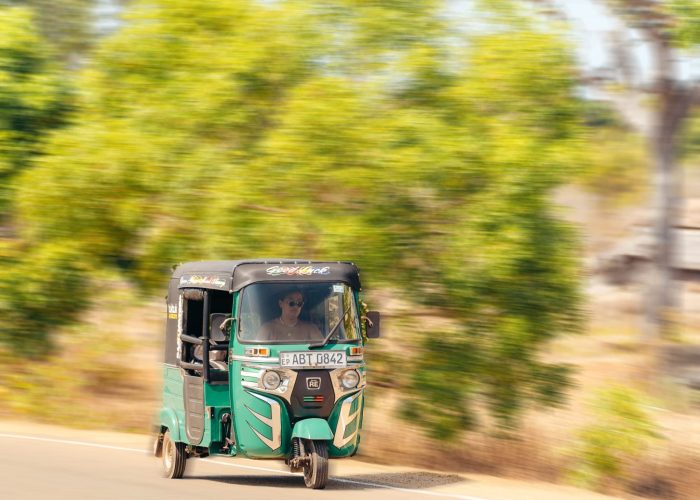
For a small island nation, Sri Lanka sure has some very diverse landscapes. From misty mountains to tropical beaches and busy cities, this country has it all and that makes an ideal destination for an epic road trip. While many people still prefer to hire drivers or do guided tours, an increasing number of travellers are now choosing to self drive to experience the island on their own terms. Especially renting a tuktuk in Sri Lanka for a self drive adventure has never been easier!
Driving yourself in a foreign country sure is an adventure of a lifetime. It gives you the freedom to stop at hidden waterfalls, take detours to lesser known temples, and travel at your own pace. However, that is not to say that everything is as easy as it comes. The roads in Sri Lanka come with their own set of challenges, and it is important to understand both the legal requirements and the unwritten customs of the road before you get behind the wheel.
This self driving in Sri Lanka guide will walk you through everything you need to know about having a successful and fun road trip across the country — from traffic laws and licensing to cultural driving norms and road conditions — so you can make an informed decision and enjoy a safe, memorable journey across this enchanting island.
Why Self-Drive in Sri Lanka?
Self driving offers a sense of adventure and independence that is hard to match. Public transport can be slow and inconsistent, and private drivers, while convenient, can limit your spontaneity.
Self driving in Sri Lanka allows you to interact more closely with local communities, discover hidden gems, and enjoy the journey as much as the destination. Sri Lanka’s relatively compact size means you can cover a lot of ground in a short time, making it ideal for travellers wanting to pack both coast and hill country into a single itinerary. With your own vehicle, you can:
- Explore off the beaten path destinations like Haputale, Ritigala, and Jaffna.
- Avoid strict tour schedules and travel at your own pace.
- Stop for local street food, snap pictures of wild elephants, or hike remote trails with ease.
Understanding the Licensing Requirements
Before you can legally drive in Sri Lanka, you need to procure a Sri Lankan driving permit against your valid International Driving Permit (IDP). Foreign nationals must carry their International Driving Permit, which must have an endorsement that allows them to drive either a car or a bike or both.
To apply for the temporary Sri Lankan driving permit that allows you to drive in the country, you will need:
- International Driving Permit (IDP) (digital IDP is also valid)
- Your passport and visa
- Two passport-sized photographs
- Around LKR 3,000 to 5,000 for application fees (about 10 to 17 USD).
The Sri Lankan driving permit can be obtained from the Automobile Association of Ceylon (AA Ceylon) in Colombo. Bring your original documents and a couple of copies of each. The process typically takes a few hours and the offices are closed on weekends and public holidays.
Some rental companies like Tuktuk Rental even take care of this process on your behalf if you book in advance, saving you time and effort. Make sure to confirm this when booking your vehicle. Ensure your permit is valid for the duration of your stay and the type of vehicle. You MUST have a physical copy of your IDP in hand when you begin your rental with us.
Choosing the Right Vehicle
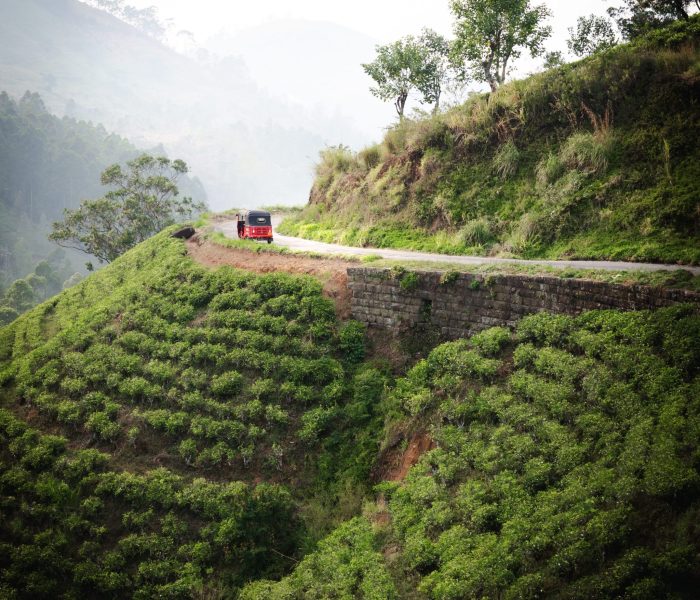
When renting a vehicle in Sri Lanka, consider your travel route and the nature of the roads. While compact cars are ideal for city driving and coastal roads, SUVs or 4x4s are better suited for hill country, unpaved village roads, or national parks. For backpackers in Sri Lanka, scooters are often a popular choice. However, there is no greater joy than driving a tuktuk in Sri Lanka!
While a tuktuk will not give you the comforts of an automatic transmission or air conditioning, it is definitely the most authentic and intimate way to get to know this country and its people. Renting a tuktuk with tuktukrental.com means our standard motor insurance is included in your rental agreement, and so is 24×7 roadside assistance in case of breakdowns. Your rental also includes comprehensive tuktuk driving lessons to make you confident on the road.
Reading the complete guide to renting a tuktuk for detailed information!
Traffic Laws You Must Know
Driving laws in Sri Lanka are not always strictly enforced and adherence by locals can be inconsistent, making self driving in Sri Lanka a little challenging. Here are some key regulations:
- Drive on the left side of the road, similar to the UK, India, and Australia.
- Seatbelts are mandatory for front seat passengers. (Not applicable if renting a tuktuk).
- Mobile phone use while driving is prohibited unless you use a hands free device.
- Speed limits vary by area:
- 50 kiloemeters per hour (kmph) in urban areas
- 70 to 100 kmph on highways
- 40 kmph near schools or hospitals
- Tuktuks are not allowed to go beyond 40 kmph.
Always carry your Sri Lankan driving permit, vehicle registration, and insurance documents. Police checks are frequent, especially at checkpoints, and you can be fined for missing documents or violating traffic rules. Also, driving under the influence of alcohol is strictly prohibited and carries heavy penalties.
As a foreign tourist, you might get stopped more often than others either by curious cops looking for a selfie or by corrupt cops looking to make a quick buck off you. So remember to be extra cautious!
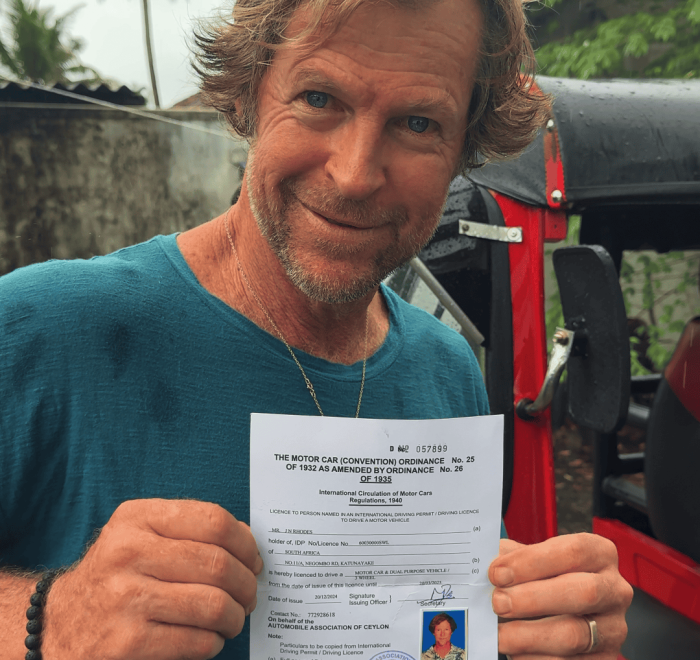
Road Conditions in Sri Lanka
The road infrastructure in Sri Lanka is generally quite good with black top and smooth roads. However, the actual conditions can vary on a number of factors:
Cities and Highways
Major cities like Colombo, Kandy, and Galle have paved roads, although traffic congestion is common. The Southern Expressway (E01), Katunayake Expressway (E03), and other major highways are in excellent condition and have toll systems. These roads are fast, safe, and easy to navigate, making them ideal for longer trips.
However, only cars are allowed to take these roads. No buses, lorries, tuk tuks or bikes can go through Sri Lankan expressways (E roads).
Hill Country Roads
Expect narrow, winding roads in places like Ella, Nuwara Eliya, or Haputale. These routes can be stunningly scenic but demand extra caution due to sharp curves, steep climbs, and misty weather. Landslides and fallen branches are also a common possibility during monsoon seasons.
Rural Areas
Village roads can be rough, with potholes, livestock crossings, and limited signage. These roads are often single lane and may not be well lit at night. GPS signals may be weak, and you might need to rely on local help or downloaded maps.

Driving Customs and Culture
Beyond formal laws, Sri Lanka has its own driving etiquette that might surprise foreign drivers, especially those who have never driven in Asia before:
The Honking Culture
Horns are not used aggressively but as a form of communication. A short honk might mean “I’m overtaking” or “Watch out.” Don’t take it personally. It is considered polite and necessary in many cases to alert other road users.
Overtaking Norms
Overtaking is common, and vehicles often overtake from the right, sometimes in risky conditions. Always check your mirrors and blind spots and turn on your indicator signals before overtaking or changing lanes. Be prepared for sudden overtaking manoeuvres by other drivers, especially buses and motorbikes.
Sharing the Road
Roads are shared with buses, tuk tuks, pedestrians, cyclists, and even animals alike. Cows, dogs, and peacocks are common road crossers. Areas around national parks might even see wild elephant crossings! Always expect the unexpected. Buses, in particular, have a reputation for aggressive driving and should be given ample space.
Traffic Police
Traffic officers are stationed at junctions and may stop you for checks. Stay polite, provide your documents, and avoid offering bribes. Most officers speak basic English and will assist you if you are lost or unsure.
Navigation Tips
Most rental vehicles come with basic GPS, but it is better to rely on Google Maps or offline navigation apps like Maps.me. Signal strength can drop in remote areas, so download your route ahead of time. Plan your route with buffer time in case of traffic delays or detours.
Keep in mind:
- Road signage may be sparse or in Sinhala or Tamil script.
- Use landmarks for navigation.
- Locals are usually helpful and happy to give directions if asked.
Fuel and Rest Stops
Fuel stations are abundant in cities and along main highways but can be sparse in remote areas. Always fill up before heading into the countryside. You can choose between petrol and diesel. If renting a tuk tuk, it will always be petrol!
Rest stops, especially on highways, are clean and offer toilets, snacks, and parking. In smaller towns, roadside eateries (known as “hotels”) serve delicious local food but may have basic facilities. Refill your water bottles and carry snacks for long drives where services may be limited.
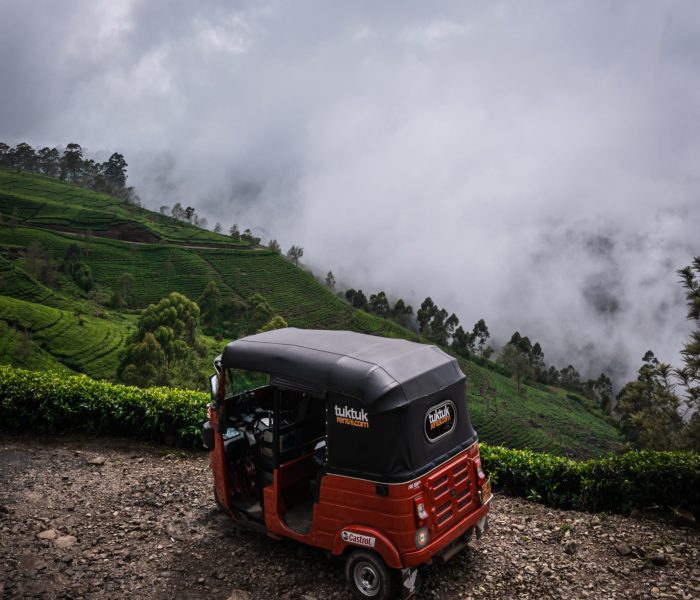
Parking and City Driving
Parking in city centres can be tricky. In Colombo, Kandy, and other urban areas, look for designated parking lots or curbside spots managed by attendants. Always ask locals or your hotel about safe parking areas, especially overnight.
Some tourist spots and hotels offer free parking, while others may charge a small fee. Avoid leaving valuables in the car, and if you park in a rural area to go hiking or exploring, make sure the car is locked and preferably within sight.
When Not to Self Drive
While self driving in Sri Lanka is a rewarding experience, it is not for everyone or every itinerary. You might reconsider if:
- You are uncomfortable with chaotic traffic or assertive drivers.
- You are on a short trip and want to maximize relaxation.
- You are travelling during monsoon season, when roads may flood or become slippery.
In these cases, hiring a driver might offer peace of mind while still enjoying the flexibility of a private vehicle. Many drivers double as informal guides, sharing local insights along the way.
Tips for a Safe and Enjoyable Road Trip
To make the most of your self drive adventure in Sri Lanka:
- Start early. Daylight hours are best for travel.
- Stick to major roads whenever possible.
- Avoid night driving, especially in rural or hilly areas.
- Drive defensively and be prepared to brake at any moment.
- Stay calm in traffic and adopt a patient attitude.
Pack a basic first aid kit, a power bank, and paper copies of important documents. Do not forget to enjoy the journey. Pull over for fresh king coconuts, chat with friendly locals, and take in the ever changing landscapes from rice paddies to tea plantations to golden beaches!
Frequently Asked Questions
Yes, tourists can self drive in Sri Lanka provided they have the proper documentation. You will need a temporary Sri Lankan driving permit. These can usually be arranged through your car rental company. With a valid permit and insurance, self driving is entirely legal and increasingly popular among adventurous travellers looking to explore the island at their own pace.
Generally, yes. Self driving in Sri Lanka is safe if you stay cautious and follow the rules. However, road conditions vary, and the driving culture can be unpredictable for foreigners. Rural areas have fewer road signs and may include hazards like animals or potholes. City traffic is often congested, and buses drive aggressively. With awareness, defensive driving, and avoidance of night travel, tourists can safely enjoy driving across the country.
Renting a car in Sri Lanka is worth it for travellers who value flexibility and plan to explore beyond the typical tourist trail. With a rental car, you can reach remote destinations, avoid crowded public transport, and travel on your own schedule. However, it is most worthwhile if you are comfortable with driving in unfamiliar conditions and have the proper license. For shorter stays or city based trips, hiring a driver may be more convenient.
Foreigners must carry either an International Driving Permit or their national driving license and obtain a temporary Sri Lankan driving permit against these documents. Always drive on the left hand side, obey speed limits, and be mindful of local customs like frequent honking and unpredictable overtaking. Use Google Maps or offline navigation, avoid night driving, and keep all documents with you. Renting through reputable companies like Tuktuk Rental and choosing the right vehicle for your route also helps ensure a smoother experience.
No, Sri Lanka is not left hand drive. Vehicles in Sri Lanka are right hand drive, and traffic moves on the left side of the road. This setup is similar to countries like the UK, India, and Australia. It may take some adjustment for drivers from right hand traffic countries, but many travellers adapt quickly. Rental cars are typically automatic, and road signage is largely understandable, especially along main routes and tourist areas.
You might also consider downloading the Tuktukrental Travel App. It features offline maps, offbeat recommendations and even helps fellow tuktuk-ers on the road connect for information or a few post-drive beers – or the local Sri Lankan arrack if you are feeling adventurous!
DOWNLOAD THE TUKTUKRENTAL TRAVEL APP TODAY

